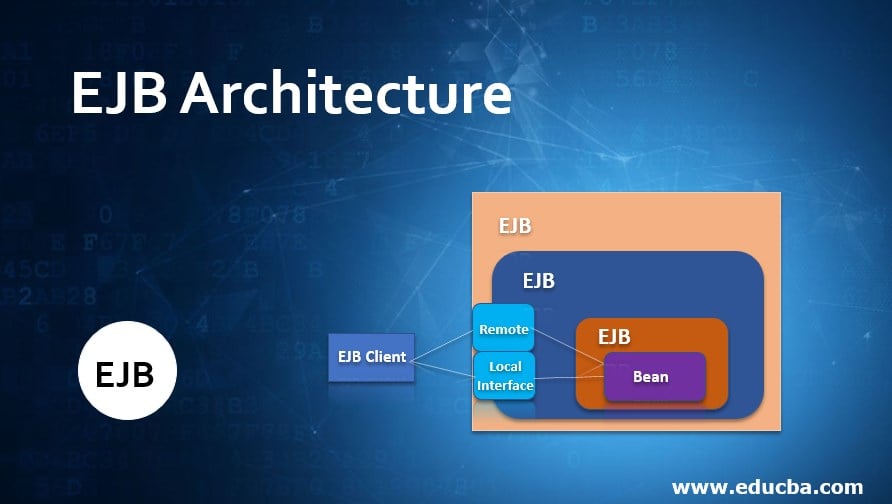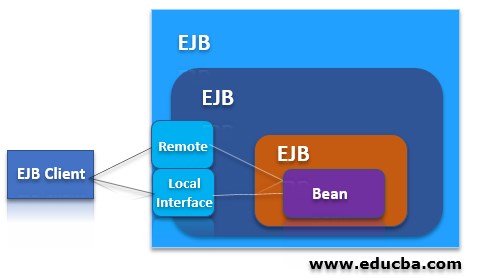Introduction to EJB Architecture
Here we will learn about the EJB Architecture and the difference between JB and EJB. So let’s explore more about it.
Java beans – JavaBeans encapsulate multiple objects into a cohesive entity that can be accessed from any application. This object is reusable, customizable, and easy to maintain. These beans are used to install stateless business logic that does not require backend status. These methods allow for the update and retrieval of variable values within an object. Lightweight Swing and Heavyweight Abstract Tool Kit are part of Java Beans.
Enterprise Java beans – It is a server-based architecture that adheres to the specifications and requirements of the enterprise environment. The beans run in a container in four-tier architecture J2EE consisting of the Client layer, Web layer, Application Layer, and Data layer.
Difference between JB and EJB
| Java Beans | Enterprise Java beans |
| Visible | Not visible, Runs as remote |
| Local, Single process and runs in the Client machine
Server-side beans are possibly not preferred |
Executed on the server-side |
| Applets and applications are built using generic
components created by Java Beans. |
It uses component technology, but it is not built or
extended over Beans. |
| It has an external interface to interpret Bean’s functionality | Works in tandem with the IDE or an external builder tool. |
| Have Property editors, Customizers and Beaninfo
classes |
No such concepts other than what is provided by
deployment descriptor. |
| No types, No support for transactions | Three types and transactions are supported. |
EJB (Enterprise JavaBeans) is a well-suited platform for building large-scale distributed applications across various industries. It provides a server-based deployment model where client machines connect to EJB beans through either the EJB Remote Interface (ERI) or the home interface. These interfaces are housed within the EJB container, which is part of the EJB application server.
In the application server, EJB (Enterprise JavaBeans) provides methods that encapsulate the essential business logic in a centralized manner. To read and update data, these techniques can be accessed remotely or locally.
This architecture has three components: Java beans, an EJB container holding these beans, and an application server housing the containers.
Architecture of EJB
1. Application Server
This server is the outermost layer in the architecture, and it holds the container. It provides the necessary environment to execute the applications developed using the beans. Web-logic, Web-sphere, JBoss, Tomcat, Wildfly, and Glass-finish are some application servers popular in the market.
The main functionality of Application servers is a. Manage Interfaces, b. Execution of the processes, c. Connecting to the database, d. Manage other resources.
2. Container
The container is the second outermost layer in the EJB structure, and it provides the following supporting services to the enterprise beans housed in it.
- Transactional services like Registering the objects, assigning remote interface, purging the instances
- Monitoring the activities of the objects and coordinating distributed components
- Security service and Pooling of resources
- Manages the Lifecycle of beans and their concurrency
- Provide a platform for the developer to concentrate on business logic
3. Beans
In terms of the programming model, an Enterprise JavaBean (EJB) deployed within a container is equivalent to a Plain Old Java Object (POJO). Beans provide business logic for developing robust, secured, and large-scale business applications.
Types of Enterprise Java Beans
Enterprise Java Beans are of three types: Session beans, Entity beans, and Message-driven beans.
1. Session beans
The client may be remote or local thru JVM.
- Stateless beans: These beans are used to install stateless business logic and do not need to meet the backend status. Stateless Bean is suitable for a mere data-capturing scenario where backend status is not.
- Stateful beans: Used in scenarios when the back-end status must be preserved. For example, applications like shipping and carts need to keep track of the backend status as part of the Application.
- Singleton beans: It refers to a class instantiated once and remains for the Lifecycle of an application.
2. Entity beans
Persistence refers to the ability of these beans to retain data even after the application has been closed.
3. Message-driven beans
These beans play a significant role in sending and receiving messages through message broker as per Java messaging server spec.
Advantages of EJB Architecture
Below are the advantages:
- Since an Application built on EJB has API characteristics, it can run on any Java enterprise edition (EE) Application
- The developer can focus on business logic and solving business pain
- EJB containers provide several services during the execution of beans
- Helps in building a robust, secured, large-scale application with
- It has many portable components refreshing current java beans applications becomes
Conclusion
EJB provides a robust platform for rolling out large-scale applications using reusable business logic present in beans. The EJB (Enterprise JavaBeans) option for application development can be evaluated at the organizational level.
Recommended Articles
We hope that this EDUCBA information on “EJB Architectures” was beneficial to you. You can view EDUCBA’s recommended articles for more information.





